With the voting of which great woman should be on the twenty dollar bill, it’s important to know the true history of this candidate, Rosa Parks. Parks is so much more than what we’ve been taught in our history classes. We all remember being taught something along the lines of, Rosa Parks feet were tired, but she was more exhausted of the oppression that she face every day.
Rosa Parks’s childhood brought her early experiences with racial discrimination and activism for racial equality.Rosa’s mother moved her family to Pine Level after divorcing Rosa’s father, Alabama to live with her parents, Rose and Sylvester Edwards—both former slaves and strong advocates for racial equality; the family lived on the Edwards’ farm, where Rosa would spend her youth. In one experience, Rosa’s grandfather stood in front of their house with a shotgun while Ku Klux Klan members marched down the street. Rosa went on to attend a segregated, one-room school in Pine Level, Alabama, that often lacked adequate school supplies such as desks. African-American students were forced to walk to the 1st- through 6th-grade schoolhouse, while the city provided bus transportation as well as a new school building for white students. In 1929, while in the 11th grade and attending a laboratory school for secondary education led by the Alabama State Teachers College for Negroes, Rosa left school to attend to both her sick grandmother and mother back in Pine Level. She never returned to her studies; instead, she got a job at a shirt factory in Montgomery.
In 1932, at age 19, Rosa met and married Raymond Parks, a barber and an active member of the National Association for the Advancement of Colored People. She soon became actively involved in civil rights issues by joining the Montgomery chapter of the NAACP in 1943, serving as the chapter’s youth leader and secretary to NAACP President E.D. Nixon. She even fought to get justice for Recy Taylor, a black woman who had been sexually assaulted by a gang of white men.
On December 1, 1955, after a long day’s work at a Montgomery department store, where she worked as a seamstress, Rosa Parks boarded the Cleveland Avenue bus for home.As the bus continued on its route, it began to fill with white passengers. Eventually, the bus was full and the driver noticed that several white passengers were standing in the aisle. He stopped the bus and moved the sign separating the two sections back one row and asked four black passengers to give up their seats. Three complied, but Rosa refused and remained seated.It was clear that her refusal to get up wasn’t because she was physically tired, but that she was tired of giving in.
Recently I’ve learned that Rosa Parks was so much more than what we’ve been told in our history classes. I think she is an outstanding woman because she put herself in harms ways just because she was tired of her people getting oppressed. I never knew how she was connected to the NAACP or of her dedication to getting justice for women of color who had become victims of sexual violence by the hands of white men. I believe that Parks’ dedication to getting justice for this woman and others who had faced the same violence was a key player in getting the movement started. I believe that Rosa Parks was an outstanding woman because she did’t want to sit around and continue to take the oppression that had been plaguing her since the day she was born… No she was tired of giving into the white men and she knew in that moment that it was time to stop. She could have been beat to death or taken advantage of; that was the danger she was facing, but she didn’t care she just didn’t want to give the white bus driver what he wanted. She didn’t want to submit to him like her ancestors had been doing for years, she saw that it was time to end the cycle. How could you say that this woman wasn’t outstanding?
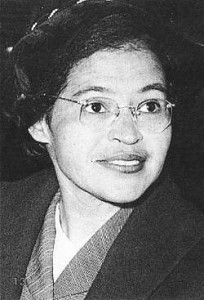
Gloria Steinem has been an outspoken champion of women’s rights since the late 1960s. She is a social activist, journalist, and lecturer that will forever be remembered. Her journey with feminism and women’s rights began after college when she took a job as a freelance writer. She is accredited with be a co-founder of Ms. Magazine and for her undercover work with The Playboy Club. She helped create the National Women’s Political Caucus, and authored many books and essays. Steinem even defeated breast cancer, and was able to celebrate her 75th birthday in 2009.
She had an unique upbringing, with her spending part of the year in Michigan and the winters in Florida or California. With all this bouncing around to other places, Gloria did not attend school on a regular basis until she was 11 years old. Steinem’s parents divorced when she was about 11 and she ended up caring for her mother, Ruth, who suffered from a mental illness. She spent six years living with her mother in Toledo before leaving to go to college. She then attended Smith College, where she studied government, which was a non-traditional choice for a woman at that time. So it was clear early on that she did not want to follow the common and easy life path for women in those days. In 1956, she graduated from Smith College with her degree.
She first worked for Independent Research Service and then established a career for herself as a freelance writer.Steinem received her big break in the writing world with one of her most famous articles her 1963 expose on New York City’s Playboy Club for Show magazine. Steinem went undercover for the piece, working as a waitress, or a scantily clad “bunny”, at the club. In the late 1960s, she helped form New York magazine, where she wrote a column on politics for the publication.
Steinem became more engaged in the women’s movement after reporting on an abortion hearing given by the radical feminist group known as the Redstockings. She then later expressed her feminist views in “After Black Power, Women’s Liberation.” In 1971 Steinem joined other great feminists, like Betty Friedan, in creating the National Women’s Political Caucus, which worked on behalf of women’s issues.
She took the lead in launching the great feminist Ms. magazine. Ms. began as an insert in New York magazine in December 1971; its first independent issue appeared in January 1972. Under her direction, the magazine tackled important topics, including domestic violence. Ms. became the first national publication to feature the subject on its cover in 1976.
From undercover writer to breast cancer survivor, this woman is truly outstanding. She is one of the greatest women’s rights activists still alive today. How cool was it that she was an undercover bunny at the Playboy Club? Feminists today have a lot to thank her, she created a great feminist magazine ( one of my favorite magazines), and she’s made a huge impact on the feminist movement. Let me just say on behalf of my fellow feminists, thank you Gloria Steinem.
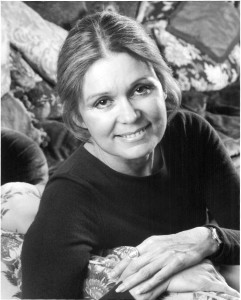
Photo Courtesy of feminist.com
Margaret Sanger was an early feminist, socialist, and women’s rights activist who coined the term “birth control” and worked towards its legalization. She worked towards achieving birth control for poor and working class women who were in need of a savior from the various pregnancies. In 1916 she opened the first birth control clinic in the U.S. with her sister, Sanger fought for women’s rights her entire life.”No woman can call herself free until she can choose consciously whether she will or will not be a mother,” Sanger said.
Margaret was born on September 14, 1879, in Corning, New York. She was one of 11 children born into a Roman Catholic working-class Irish American family. Her mother had several miscarriages, and Margaret believed that all of these pregnancies took a toll on her mother’s health and contributed to her early death.
Sanger attended Claverack College and Hudson River Institute in 1896. She then went on to study nursing at White Plains Hospital four years later. In 1902, she married William Sanger, an architect. The couple would later move to New York City in the Manhattan area, where Sanger joined the Women’s Committee of the New York Socialist Party and the Liberal Club.She became a supporter of the Industrial Workers of the World union, she participated in a number of strikes.
In 1912, Sanger started her campaign to educate women about sex by writing a newspaper column called “What Every Girl Should Know.” At the same time she also worked as a nurse on the Lower East Side, at the time a predominantly poor immigrant neighborhood. Sanger treated a number of women who had undergone “back-alley” abortions or tried to self-terminate their pregnancies. Sanger objected to the unnecessary suffering endured by these women, and began her fight to make birth control information and contraceptives available no matter a women’s social class standing. She o began dreaming of a “magic pill” to be used to control pregnancy, she believe women should have control over their own bodies and should decide when they have children.
In 1914, Sanger started a feminist publication called The Woman Rebel, which promoted a woman’s right to have birth control. The monthly magazine landed her in trouble, as it was illegal to send out information on contraception through the mail. The Comstock Act of 1873 prohibited the trade in and circulation of “obscene and immoral materials.” But instead of facing a possible five-year jail sentence for the publication, Sanger fled to England. While in England, she worked in the women’s movement and researched other forms of birth control like diaphragms, which she ended up smuggling back into the United States.
A year later, Sanger returned to the United States, after charges against her had been dropped. Once back in the States she began touring to promote birth control, a term that she coined. In 1916, she opened the first birth control clinic in the United States. Sanger and her staff were arrested during a raid of the Brooklyn clinic a mere nine days after it opened. They were charged with providing information on contraception and fitting women for diaphragms; Sanger and her sister spent 30 days in jail. Later she appealed her conviction, and she scored a victory for the birth control movement. The court wouldn’t overturn the earlier verdict, but it made an exception in the existing law to allow doctors to prescribe contraception to their female patients for medical reasons.
Margaret Sanger was an outstanding women not because she allowed for women to be sexual without a consequence. No she was a great woman because she gave women control over their own bodies for the first time. Sure the Catholic Church was upset that now its followers can have pre-marital sex without consequences, but that didn’t stop her. Margaret wanted to give the women in the poor and working class a chance to survive and not die young from numerous child births or have children suffer because their parents couldn’t handle so many children living in poverty.
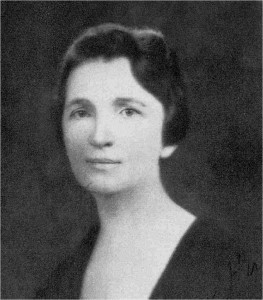
Photo Courtesy of forethought-trail.org
Ida B. Wells was born a slave, but is known for being an African-American journalist and activist who led an anti-lynching crusade in the United States in the late 19th century ( 1800s). She was a clever and resourceful lady, and that is shown in how she was able to persuade a country school administrator to give her a job as a teacher at the age of 18.
The Wells family was declared free peoples by the Union, about six months after Ida’s birth, thanks to Lincoln’s Emancipation Proclamation. They remained in the South after gaining their freedom living in the state of Mississippi. As newly freed African Americans, they faced racial prejudices and many restrictions due to discriminatory rules and practices.Wells’s parents were active in the Republican Party during Reconstruction. Her father, James, was involved with the Freedman’s Aid Society and helped start Shaw University, a school for the newly freed slaves, which is now known as Rust College. Ida received her early schooling at Shaw University, but she had to drop out at the age of 16, when both of her parents and one of her siblings died in a yellow fever outbreak. With the death of her parents, Ida was given the responsibility of taking care of her remaining younger siblings. In 1882, Wells moved herself and her siblings to Memphis, Tennessee, to live with an aunt. Wells then continued her education at Fisk University in Nashville.
In May 1884, Wells began her journey with changing the treatment of her fellow African Americans. She had bought a first-class train ticket to Nashville, and was outraged when the train crew ordered her to move to the car for African Americans despite the fact that she was a lady. Of course she refused, and she was forcibly removed from the train. As they attempted to remove her, she bit one of the men on the hand. Wells ended up suing the railroad, and won a $500 settlement in a circuit court case. The decision was later overturned by the Tennessee Supreme Court.
This injustice led Ida to write about issues of race and politics in the South. She used the nickname “Iola,” and wrote a number of articles that were published in black newspapers and periodicals. She eventually became an owner of the Memphis Free Speech and Headlight, and the Free Speech. Besides being a journalist, Wells also held a position as a teacher in a segregated public school in Memphis. In 1891, she was fired from her job for publicly criticizing the conditions of the blacks only schools.
On March 25, 1931, Ida B. Wells died from kidney disease at the age of 69, in Chicago, Illinois. She left behind an impressive legacy of social and political heroism. Wells fought against prejudice, no matter what potential dangers came her way.
She was an outstanding woman from the very beginning, starting with taking on the responsibility of care giver for her siblings all while dealing with the loss of her mother and father. She was truly a strong woman. Ida B. Wells had some major guts, and risked her life many times with her actions to get justice for her people. The African American community owes a great big thanks to Ida and so do women. I think that she is a hero for both African Americans and women; she may have not gotten amendments passed or ended oppression, but she worked her tail off to get pretty darn close.

IDA-B-WELLS
Photo courtesy of Newsreel.org
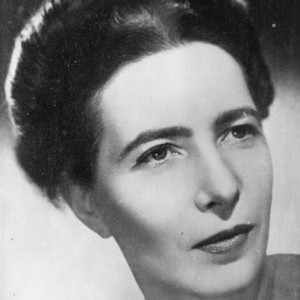
Photo is courtesy of brainpickings.org
Who is Simone de Beauvoir? Simone de Beauvoir is known as the French writer who laid the foundation for the modern feminist movement.Her best-known work is 1949’s The Second Sex, a feminist text.
Simone de Beauvoir was born on January 9, 1908, in Paris, France.She was the eldest daughter in her family, and was raised strictly Catholic. However as a young girl, she became an atheist and decided to dedicate her life to the study of existence. At age 21, de Beauvoir left home to attend the Sorbonne, where she studied philosophy and graduated in 1929. That very same year, her life and ideals would forever change when she met famed French philosopher Jean-Paul Sartre.
De Beauvoir and Sartre had a life-long partnership. The two were best friends and lovers and often influenced each other’s work and philosophy. They never married because of de Beauvoir’s insistence that their relationship should not be “defined by institutional norms”. The couple even dated other people and once formed a three-way relationship in the early 1940s with a student named Olga Kosakievicz.
She was also a professor at the Sorbonne from 1941 to 1943. Surprisingly, during the Nazi occupation of France, de Beauvoir was able to continue working without opposition from the Germans. During the war, Simone was able to write books that analyzed war, its reasoning, and the moral issues behind it.
In 1943, de Beauvoir published her first fictional book, L’Invitée (She Came to Stay), based on her experiences in relationships with Sartre and Kosakievicz. L’Invitée considers existential ideals, and more specifically the complexity of relationships and the issue of a person’s conscience as related to “the other.” It seems as though her relationships with other was like experiments and evidence for her to use in her work; mixing business with pleasure if I might be so bold to say.
But it wasn’t until Le Deuxième Sexe (The Second Sex) was published in 1949 that de Beauvoir gained notoriety. The 972-page book, wanalyzes reasons why women’s role in society was characterized as inferior to men. This book was seen as highly controversial when it first came out.
De Beauvoir’s interest in politics increased a great deal after World War II. By the 1950s, de Beauvoir became a critic of Capitalism, and was even defending the Communist governments of China and the Soviet Union. In 1947, she took a five-month trip in the United States, reinforcing many of her beliefs, and then in 1948 she published L’Amérique au jour de jour (America Day by Day). It was a critical analysis on the social problems, class inequalities and racism that she witnessed during her time in the United States.
Simone de Beauvoir is considered an outstanding woman in history in my book because her work really contributed to feminist thought and it was even different from what feminists were writing about at the time. She questioned what relationships really were and what men and women’s roles were in it. She used her own relationships as experiments or evidence for her books, which made her beliefs in that subject matter more credible. Let’s not forget that this woman was still able to do research and write like she usually would do while the Nazis were occupying her nation.
We all know Eleanor Roosevelt as the wife of President Franklin D. Roosevelt, but this woman was so much more than just a wife to the president. This woman changed the role of the first lady through her active participation in American politics. She was a first lady, writer, humanitarian and an outspoken woman.
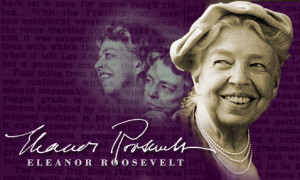
Photo courtesy of pbs.org
She was born in New York City on October 11, 1884, and she was the niece of Theodore or Teddy Roosevelt.Eleanor was known as a shy child, and experienced tremendous tragedy at such a young age when her mother died in 1892 and her father died two years later. She was only 10 years old by the time both had passed. Eleanor was then sent to school in England when she was a teenager and it would bring her out of her shell turning her into the outspoken women we all know about.
In 1905, Eleanor married her distant cousin and future President of the United States, Franklin D. Roosevelt. Eleanor and FDR had six children: Anna, James, Franklin ( died as an infant), Elliott, Franklin Jr. and John. Even with such a busy home life raising five children, Eleanor became active in public service during World War I, working for the American Red Cross. Eleanor helped her husband with his political career, after he suffered a polio attack in 1921.
In 1933, Eleanor dramatically changed the role of the first lady when her husband took office as the President. She wasn’t content with staying in the background and handle domestic matters. No she wanted to show the world that the first lady was an important part of American politics and not just arm candy for the President. So she gave press conferences, spoke out for human rights, children’s causes, women’s issues, and worked on behalf of the League of Women Voters. She even found time in her busy life as mother and First Lady to write her own newspaper column, “My Day.” She also focused on helping the country’s poor, and stood against racial discrimination.
After her husband’s death, on April 12, 1945, Eleanor told interviewers that she didn’t have plans for continuing her public service: “The story is over,” she reportedly stated. But as expected, she couldn’t sit still when there was still a lot of work to be done.From 1945 to 1953, Eleanor served as a delegate to the United Nations General Assembly. Then she later became chair of the UN’s Human Rights Commission.Eleanor was a member of the Human Rights Commission during the time where the UN was writing the Universal Declaration of Human Rights. Her contribution to the important and famous document is something she considers her greatest achievement.
Eleanor Roosevelt was truly an outstanding woman. She transformed the role of the First Lady in politics greatly and made a huge impact on the nation. Not to mention that she had to deal with a cheating husband who died from a disease contracted from his mistress. She was a strong lady and it was clear that she really cared about leaving her mark on the nation.
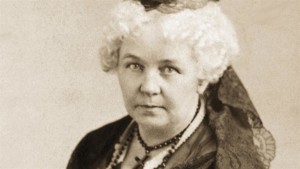
Photo courtesy of http://www.biography.com
Elizabeth Cady Stanton was one of the great early leaders of the woman’s rights movement. She is known for writing the Declaration of Sentiments, which was a call to arms for female equality. Stanton was the president of the National Woman Suffrage Association for 20 years and worked closely with another great women’s rights activist, Susan B. Anthony. Her advocacy of liberal divorce laws and reproductive self-determination is what lead her to become of the most involved and celebrated suffragists. Elizabeth Cady Stanton’s efforts ultimately helped bring about the passage of the 19th Amendment, which gave all citizens the right to vote.
Elizabeth was born on November 12, 1815, in Johnstown, New York.She was the daughter of a lawyer who made it no secret that he had longed to have a son instead. Elizabeth showed her desire to excel in intellectual and other “male” spheres starting at a young age.
She graduated from the Emma Willard’s Troy Female Seminary in 1832 . Shortly after, she was then drawn to the abolitionist, temperance, and women’s rights movements during her many visits to the home of her cousin, who happened to be a reformer as well, Gerrit Smith. In 1840 Elizabeth married a reformer Henry Stanton, and quite fitting they even omitted “obey” from their marriage oath. The two newly weds then immediately left to join their fellow reformers at the World’s Anti-Slavery Convention. Though Elizabeth could not join her husband in the actually conference due to the exclusion of women there, instead she joined the other women there that were fighting for their right to be included in the convention.
Elizabeth is mostly known for her outstanding work in the Women’s Rights movement that all began with the famous Seneca Falls Convention that she held alongside women like Lucretia Mott . At this meeting, the attendees drew up its “Declaration of Sentiments” and she took the lead in proposing that women be granted the right to vote. After the convention, Elizabeth still continued to do speeches about the importance and need for Women’s Rights, inspiring others like Susan B. Anthony to join the cause. During the Civil War Elizabeth Cady Stanton took a short break from women’s suffrage and turned her efforts on abolishing slavery, but afterwards she became even more fired up when it came to promoting women suffrage.
In 1868, she worked with Susan B. Anthony on the Revolution, a militant weekly paper. The two then formed the National Woman Suffrage Association (NWSA) in 1869. Stanton was the NWSA’s first president , which she held until 1890.
Elizabeth Cady Stanton falls under the category of an outstanding women for many reasons. Women would not lead the same lives that they do now; they wouldn’t have the right to vote and ultimately become more equal to men. She is outstanding because she had a goal and dream to see women and men equal and for women to have a say in their own country. Her determination inspired many others to make a difference and still does today. I thank Elizabeth Cady Stanton for my right to vote and the inspiration to make a difference.

Photo courtesy of HistoryOnline: Russian Tzars
Catherine the Great, also known as Yekaterina Alexeevna or Catherine II was the widely known and longest ruling female leader of Russia. She reigned from 1762 up until her death in 1796 at the age of 67.She led her nation into the political and cultural life of Europe, continuing what Peter the Great started and what her husband failed to do. She became the empress of Russia in 1762, and under her Russia expanded its territories and modernized the nation.
She was born May 2, 1729 in Prussia ( known as Poland today). She began as a minor princess only to grow to be a powerful empress. She was educated by tutors and had religious studies with a military chaplain, but she questioned much of what he taught her. She also became trilingual being able to speak German, French and Russian.
During her youth though, she allowed herself to become a way for her mother to climb the social ladder; her mother would look for all of the possible suitors for her from day one it seems. Marriage was a way to get out of her mother’s controlling grasp, according to Catherine. 1744, a teenager Catherine traveled with her mother to Russia to meet with the Russian Empress, but she soon fell ill. The decision of her treatment created a conflict between her mother and the Russian Empress, Elizabeth.
Once she had recovered, she began her relationship to Grand Duke Peter. The pair became engaged, and Catherine even converted to the Russian Orthodox faith, even though her hugely Lutheran father’s objections. With her new religion, she also received a new name Yekaterina, also pronounce or known as Catherine.On August 21, 1745, Catherine II married into the Russian royal family, becoming a grand duchess.
Empress Elizabeth died in December 25, 1761,and Peter assumed the throne, becoming Peter III, while Catherine received the title of Empress Consort. Peter was openly cruel to his wife especially once he took the throne. He often discussed pushing her aside to allow his mistress to rule with him. After six months, Peter was overthrown in a conspiracy led by his wife. Catherine had conspired with her lover, Gregory Orlov, a Russian lieutenant, along with several others in order to unseat her cruel husband. She was able to get him to step down from power, and then assumed control herself.
Catherine believed in absolute rule, but she did make some efforts toward social and political reforms. She put together on document, the “Nakaz,” on how the country’s legal system should run. This document also called for a push for capital punishment and torture to be outlawed and calling for every man to be declared equal.
Catherine the Great falls under the category of an outstanding women because although she had to kill her husband to gain the throne, she still did a great job. She called for the necessary reforms that her nation was in need of, even if not everyone was completely for it. Even though she seemed like she lived a magical life being a princess and all, but her husband was horrible towards her; she didn’t really raise her own child; and she was controlled and used by her mother during her youth.Catherine was intelligent and ambitious, quite ruthless, sexually insatiable. She was the most powerful woman in the world, bringing Russia out of its medieval stupor and into the modern world.
For my first outstanding woman, I bring you the famous Cleopatra of Egypt; she is one of the most famous female rulers in history. She lived from 69 B.C. to 31 B.C. in Alexandria, Egypt. She is most often known because of her relationships with two very powerful Roman rulers; Julius Caesar and Mark Antony. But really Cleopatra has so much more to be known for, she was actually a very clever leader; not only did she influence politics of her own empire, she also influenced that of Rome’s politics. She was very resourceful and cunning, after the murder of Pompey, she knew that she needed Roman support to keep her position on the throne, hence why she cozied up to Julius Caesar. She was the last of a long line of rulers called the Ptolemies, who ruled Egypt for nearly 300 years; she was also the last true Pharaoh of Egypt.
What we must realize from historians’ and archaeologists’ findings, Cleopatra isn’t just some sexy queen that just bats her eyelashes and relies on her looks. Cleopatra was fluent in more than just her native tongue. Sure she did use her exotic Egyptian beauty and art of seduction to gain the trust of both Caesar and Antony for military muscle, but it was ultimately her clever mind that made her such a great candidate for the throne. This female ruler most definitely proved that she had a right to rule Egypt and other territories.
Cleopatra was not alone in the task of ruling all of the Egyptian empire, for most of her time on the throne she was accompanied by her two younger brothers and then later her own son; this amounted to three decades of shading the power of the throne. Due to her knowledge of multiple languages, she was the dominant ruler of the three. She was forced to marry her younger brother Potemly XIII, who was twelve at the time, but she never took his name. She had her own portraits made and even her own coins, she wasn’t going to stand aside and watch him rule Egypt; she wanted her power. Not too soon after the siblings’ ascension to the throne, her brother’s advisers acted against Cleopatra, and she was forced to to run Syria in 49 B.C. The following year, she raised an army of mercenaries and returned to face her brother’s forces and take back her rightful place on the throne.
When the emperor Octavian defeated Antony and Cleopatra’s military, rumors spread of her suicide and ultimateily caused the death of Antony. After discovering his body and burying him, Cleopatra actually committed suicide, sealing herself in with two of her female servants. No one really knows how she killed herself, but some historians like the writer Plutarch believe she died from the bite of an asp, a deadly snake that was seen as a symbol of divine royalty.
So why did I chose to discuss the ancient female Pharaoh of the great Egyptian empire? Well it’s simple… From our history classes and Hollywood, we only see Cleopatra as a beautiful female ruler who had relations with two powerful men of the Roman Empire; but really she was so much more than whah her relationships said about her. Cleopatra was a great female ruler and she deserves more credit for her time in power. I wouldn’t have known of her political greatness I I hadn’t taken a class on the women of the ancient world. I think it’s time she was recognized for not just her beauty, but her knowledge and actions as ruler of Egypt. Unlike novelist Margaret George and historian Stacy Schiff, I don’t believe that she was a whore. I think that they just can’t see how she used her sexuality to her advantage. If anything she is a feminist icon, she fits the mold of a feminist. She didn’t need a man to rule, instead she used the men in her life like pawns in chess, to get what she wanted.
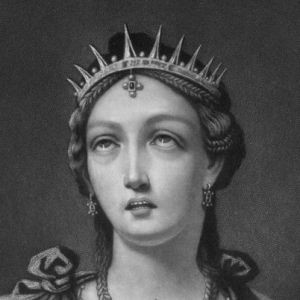
Hypatia, (born c. 355 ce—died March 415, Alexandria), Egyptian mathematician, astronomer, and philosopher who lived in a very turbulent era in Alexandria’s history. She is the earliest female mathematician of whose life and work reasonably detailed knowledge exists. Hypatia of Alexandria was the first female to contribute substantial developments in mathematics, hailing from the times of the ancient and mighty Roman empire.
She was the daughter of the mathematician and philosopher Theon, who taught her mathematics, science, literature, philosophy, and the arts. Her father also desired for her to be the “perfect human being”, so they exercised daily to get her just a step closer to the title. This seemed to be a close father-daughter relationship, I mean she even did commentary in some of his books; Theon’s book three of his version of Ptolemy’s Almagest was actually the work of his amazing daughter. Hypatia became head of the Platonist school at Alexandria in about 400 AD, which was quite astonishing and unheard of due to her being a woman. She lectured on mathematics and philosophy at the Platonist, teaching the philosophy of Neoplatonism. Hypatia based her teachings of the founder of Neoplatonism and a developer of Neoplatonism around 300 AD. Hypatia symbolizes learning and science which the early Christians identified as paganism. The funny thing is that among the pupils who she taught in Alexandria there were many prominent Christians. Of her pupils one of the most famous is Synesius of Cyrene who would later to become the Bishop of Ptolemais.
In 415, Hypatia was condemned as a witch and was murdered by monks.Hypatia became the victim of a particularly brutal murder at the hands of a gang of C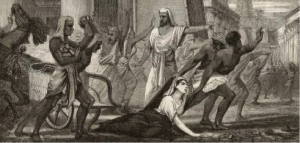 hristian zealots. On the streets of Alexandria, Egypt, a mob led by Peter the Lector stripped Hypatia of her clothes, beat her to death with roofing tiles, tore her body into pieces and burned the pieces. Hypatia was living during a time of religious strife, her love of astronomy Hypatia was her doom, making her a pagan in the eyes of the ruling officials.
hristian zealots. On the streets of Alexandria, Egypt, a mob led by Peter the Lector stripped Hypatia of her clothes, beat her to death with roofing tiles, tore her body into pieces and burned the pieces. Hypatia was living during a time of religious strife, her love of astronomy Hypatia was her doom, making her a pagan in the eyes of the ruling officials.
Hypatia was not only a mathematician, she was an astronomer and philosopher as well.She is the earliest female mathematician of whose life and work reasonably detailed knowledge exists. Hypatia is considered an outstanding woman in my book because she was in a field that was foreign for women, but she didn’t let being a woman kept her from studying and teaching. We don’t hear about her often or really at, but we need to keep in mind that the ancient world was focused on the accomplishments of men. Women were seen as property and just baby makers. Hypatia never got married, she stepped out of the typical life of a women to make a difference and shape the minds of what appears to be some pretty prominent people. It was clear that she was in control of her own life. You don’t hear much about women that weren’t qHypatia_Humanity-Healing-204x300ueens, and she was clearly an amazing character. Someone saw her importance and actually made a movie called Agora starring Rachel Weisz, about Hypatia a couple years back which is pretty awesome. Hypatia is considered an outstanding woman to me because she stepped outside of the typical role of a woman. She wanted to play with the big boys and give them a run for their money.
*Photos courtesy of Smithsonian Magazine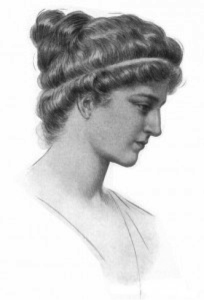









 hristian zealots. On the streets of Alexandria, Egypt, a mob led by Peter the Lector stripped Hypatia of her clothes, beat her to death with roofing tiles, tore her body into pieces and burned the pieces. Hypatia was living during a time of religious strife, her love of astronomy Hypatia was her doom, making her a pagan in the eyes of the ruling officials.
hristian zealots. On the streets of Alexandria, Egypt, a mob led by Peter the Lector stripped Hypatia of her clothes, beat her to death with roofing tiles, tore her body into pieces and burned the pieces. Hypatia was living during a time of religious strife, her love of astronomy Hypatia was her doom, making her a pagan in the eyes of the ruling officials.